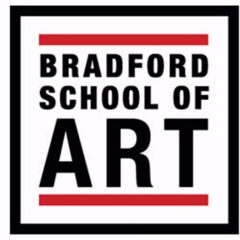To support the creation of my project I am required to conduct some secondary research, this is done to help develop my project and ensure quality upon creation, for my secondary research I decided to use several sources, these being online websites, YouTube videos, online articles, news articles, historical records ect.
Youtube
The first place I decided to look to help me gather some useful and useable research sources was YouTube, as it contains a vast amount of videos on a wide range of topics, some of which are inevitably related to the subject I am researching, that being what makes a rogue-like game good, how they are made, why they are repayable, common themes and conventions, ect.
After watching various videos on how rogue-like games are made, what goes into them ect, I came across this video, the creator of the video first delves into how defining rogue-likes are a hotly debated issue, as the definition of a rogue-like is not so simple, he describes how many different games can be considered a rogue-like and he labels the keys traits of rogue-like games, this was insightful as it informed me of key characteristics of the type of game I intend to make.
He then explores the history if rogue-likes and how they have revolved over time, explaining how the term “Rogue-Like” actually derives from a search board where players expressed their desire to find a game similar to a popular game at the time called “Rogue” which is a dungeon crawler initially released in 1980, this was helpful as I was able to look at the first rogue-like and see how they’ve developed, allowing me to take inspiration from all of them, regardless of how old.

The video also delved into the 8 must have’s for Rogue-Like games, this being a checklist developed at the International Rogue-Like conference in Berlin 2008, these being the following;
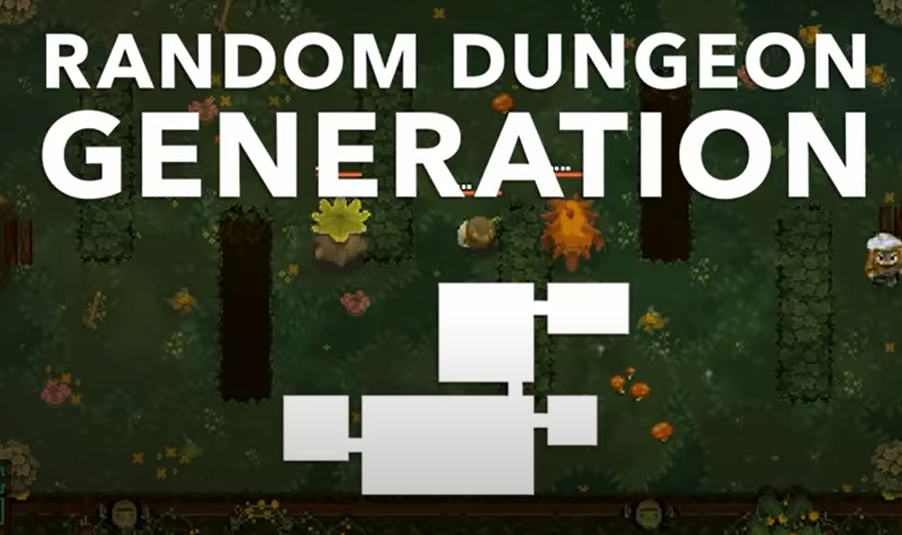



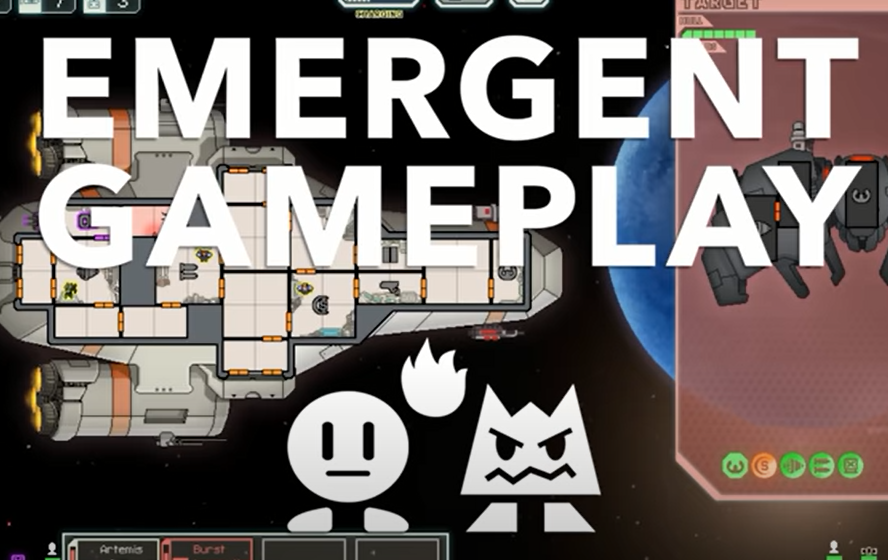
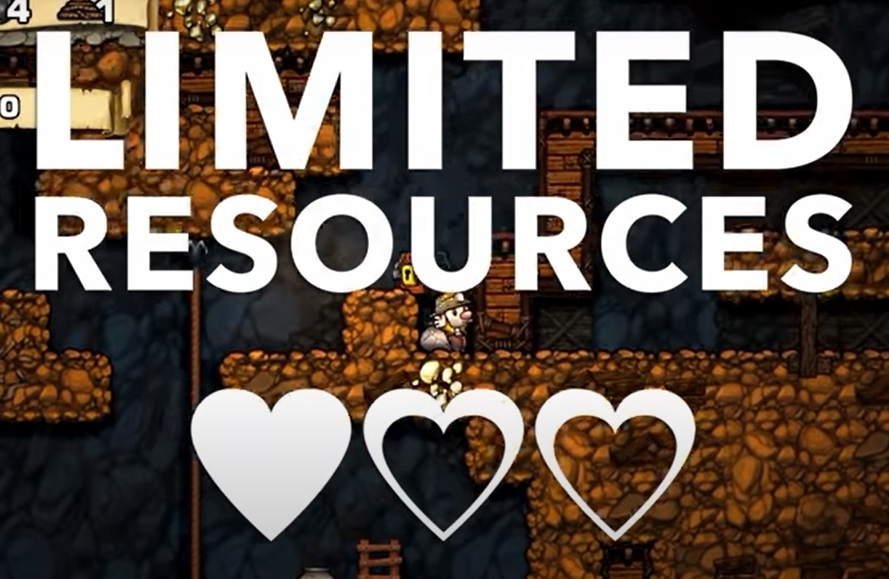
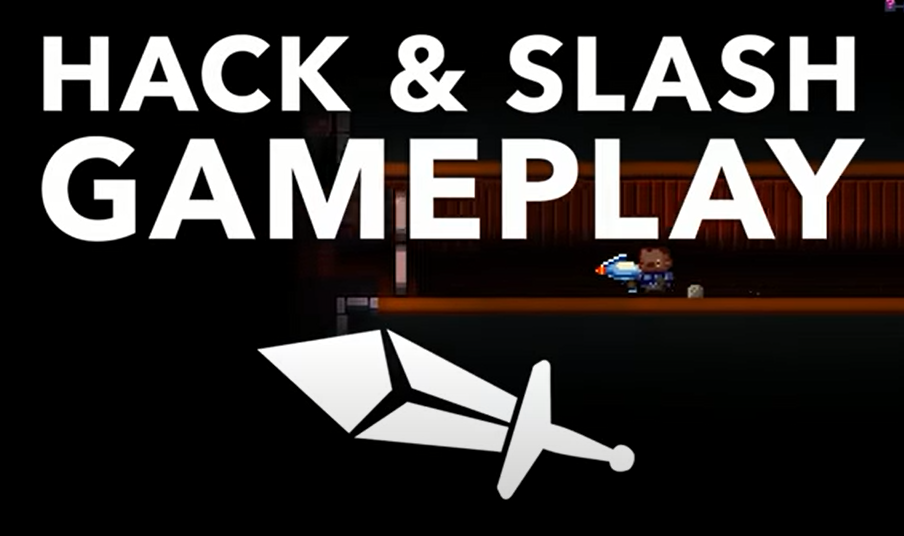
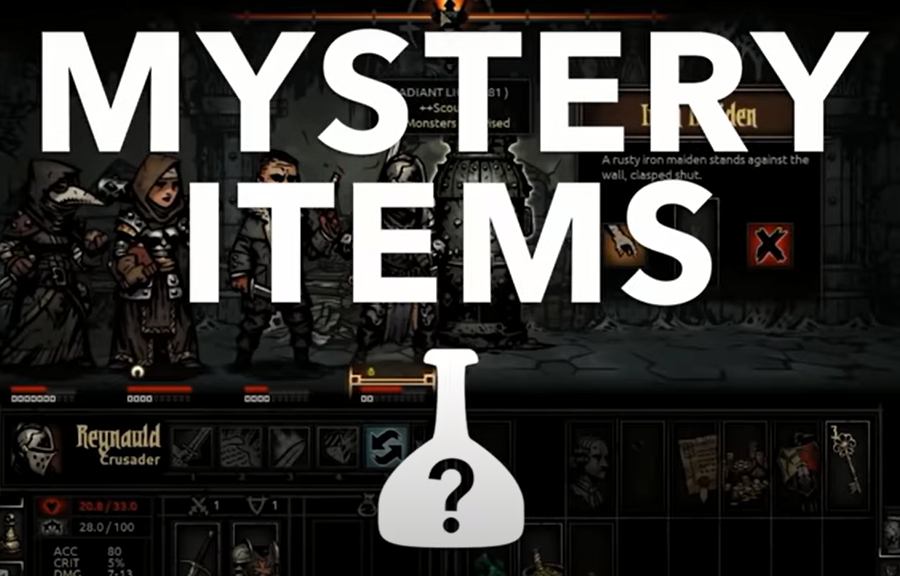
These key themes and functions essentially boil down too:
Random Dungeon Generation: Each room is different from the last, the player won’t encounter the same room twice unless it is intentional, such as a boss arena.
Permadeath: The player character loses most if not all of their items upon death, this encourages the player to be strategic and play rationally, raising the stakes for the player, creating run based gameplay.
Turn-Based-Gameplay: The player character decides when they want to enter a fight, and have as much time to prepare as they want, unless intentional.
Non-Modal Gameplay: The character isn’t restricted to one playstyle or area, and has access to all the content at the beginning of the game, having access to all actions and there isn’t any changes in modes during gameplay.
Emergent Gameplay: The game operates under strict rules, such a fire that damages the player also damages non resistant enemies, poison will damage the player but only if they are touched without resistances, things such as health/stamina/mana ect.
Limited Resources: The player doesn’t have access to every item in the game and cannot always return to full strength easily, this encourages the player to be strategic and adjust their playstyle accordingly, resources such as health are often scarce if not non existent, unless intentional.
Hack & Slash Gameplay: The game operates at a high intensity fast pace combat, usually pushing the player to grow in skill and not rely blindly on luck, whilst also giving the player time to react and learn from mistakes.
Mystery Items: Inclusion of items or rooms which the player doesn’t know about, such as a door to a room the player doesn’t know what’s inside, or an item of which isn’t known until picked up or used, even if the player has used or seen said item or room before, the aspects and properties of them can change throughout or on repeated playthroughs.

This interpretation of rogue-like games lays the groundworks for how these games are made, the video overall was extremely insightful and taught me many new things including the ones listed above, many of which will be implemented into my Final Major Project, whilst also expressing that the rules established above do NOT need to be used within a rogue-like and can be tinkered with to the developers needs and aspirations, they simply lay a path for an aspiring gave dev to follow.
One other YouTube video I found to be insightful and useful would be the following, this delves into the 2 different types of Random in gaming, and explores the difference between the two and how it effects the games they are included in, this was especially helpful as my game will include one of said random mechanics.
The video first delves into how RNG effects players, and how the mechanic can be both a blessing and a curse to players, leading to happiness or pure rage, this is inevitable as random number generators can dictate an entire players run, and can be kind to some but terrible to others, this is especially true to rogue-likes which often rely on Random Number Generators, this is also a major appeal for players, as they never know what to expect.
It also explains why Randomness is used in games in the first place, to create variety, an algorithm can create thousands of different levels, items, characters and NPC’s, all of which accumulate into an entirely separate game for each player, this is done to keep each game fresh and new/exciting to play, displaying games such as Shadow Of Mordor and its randomly generated Orc Captains, and Minecraft with its procedurally generated worlds to help emphasize this.
The video and explains the underlying diference between the two randoms, pulling up two different games to help do so, the difference is as follows;
A game of which is randomly generated, but then shown to each and every player which plays the game, and a game which randomly generates a completely different environment for each and every player, the games which are mentioned are No Mans Sky, and Minecraft.
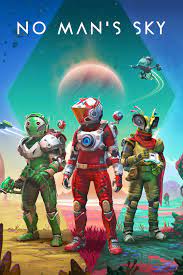
No Mans Sky employs a random number generator which automatically generates “18 quintillion planets” which are distributed to every player, the game is random, but the worlds are not.

Minecraft on the other hand uses a random number generator which is truly random, as no player will ever receive the same world unless a specific seed is entered into the seed box.
This video was helpful in helping me distinguish the difference between the 2 RNG’s and helped me decide which of the two I want to use in my own game, further assisting me in keeping my game as random as possible.
Another aspect of the game I wish to develop would be how much skill is required to play, for example could a newcomer pick up the game and learn the mechanics and gameplay quickly? Traversing through each room with ease and inevitably becoming a master, or would they struggle and push themselves, hauling themselves from room to room and valuing every item/health point preciously, overcoming challenges in pursuit of their final goal?
To answer this very question I searched for videos on Youtube, and eventually came across one which benefited me in this regard massively, the video itself delved into the mechanics of 8 different games, listing the skill-luck ratio of each one, essentially breaking down which game required how much skill to play, and which ones relied more heavily on luck, this was helpful as i t helped me come to the conclusion that my own game would be Luck over Skill based.
The video rated each of these 8 games on a 1-10 ratio of skill-luck, taking into account randomness and variability and analyzing each of these 8 games to find out which of the bunch required the most/least skill to play.
The first game they analyze would be Binding of Isaac, talking about what makes the game fun/luck based, talking about the games unique rarity system, and the inclusion of items which can actually harm a players run, reducing stats and impacting important mechanics, such as health.
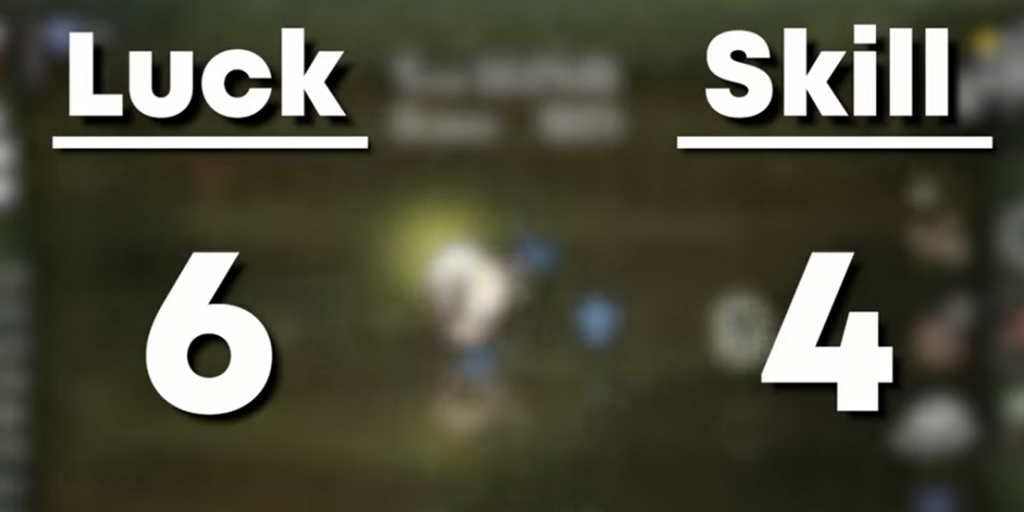
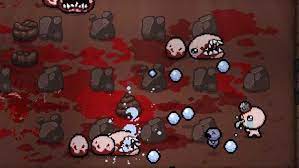
They also analyze the games different ingame mechanics which impact a players run, such as it’s luck based boss drops, luck based in-game jackpot machines jamming, and the inclusion of RNG based player damage, due to all these factors the creator gives this game a rating of Luck 6, Skill 4.
The next game the creator reviewed was Slay the Spire, another Rogue-Like which is known to be a very influential card based rogue-like, the game also differs itself from all the other games reviewed, as the game has no mechanical gameplay, as different areas require different items, whilst in most other Rogue-Likes the player can theoretically beat any boss with any equipment, whilst in this game you cannot.
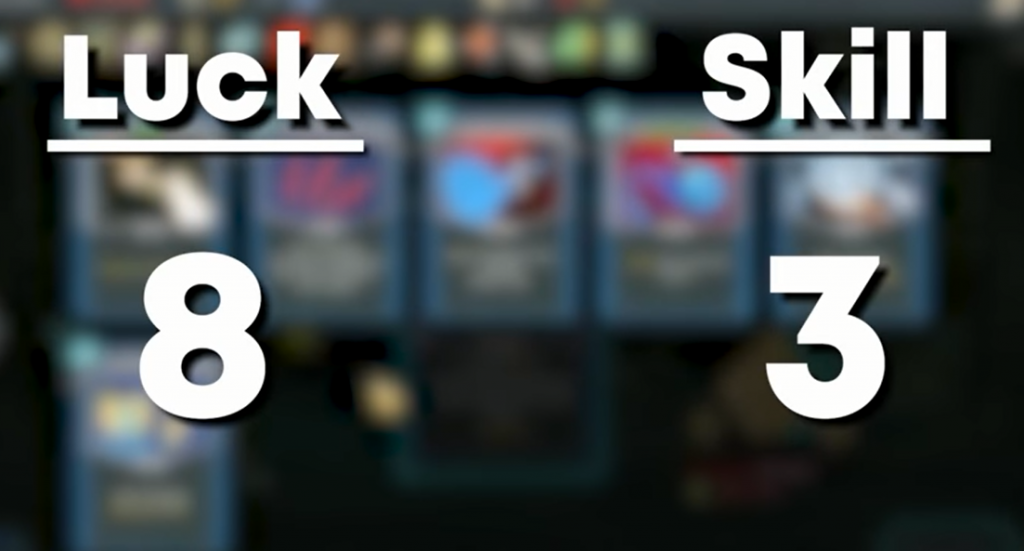
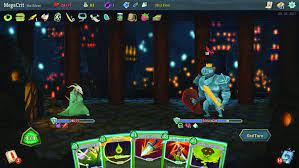
One mechanic which is discussed in the video would be the randomness of bosses, which can completely ruin a players run if they happen to get an unlucky boss roll, which can infuriate many players as they may face a boss which their current deck cannot harm or cannot beat, regardless of how they play, due to these factors they gave this game a rating of Luck 8 and Skill 3.
Next to be rated was the game Enter The Gungeon, which is a bullet hell rogue-like, and they explain the tier system in the game and how it doesn’t particularly matter what item the player gets, they can still beat the game with most if not all items, also mentioning the lack of resources the game gives you overall, also mentioning that most items within the game are helpful.
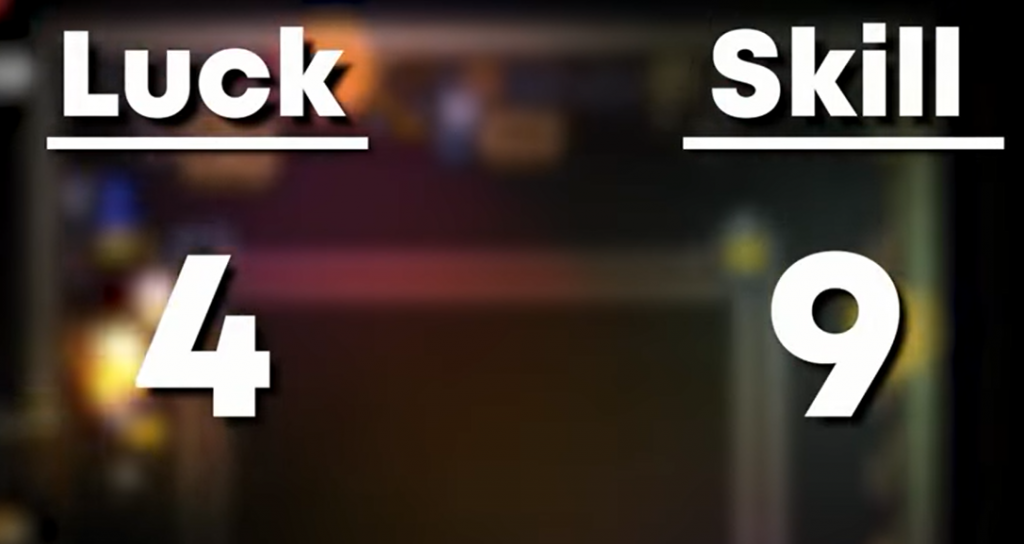

The game overall tests the player, forces them to adapt to new enemies and rewards them for it, whilst still ensuring that they stay on their toes and never becomes too relaxed, as a new enemy of which may be unseen to the player beforehand may appear, whilst the item drops are completely random as mentioned before all items are helpful in their own way, for this they gave Enter The Gungeon a rating of Luck 4 and Skill 9, the highest skill seen so far.
The 4th game to be reviewed is Risk Of Rain 2, which is a 3rd person Looter-Shooter Rogue-Like (the first of which to be seen thus far,) the video then explains the games unique timer mechanic, and its In-Game tier system, but also explains that the tier system isn’t detrimental to success, also explaining the discrepancy between common-legendary items, which means if the player gets a higher tier weapon they are much more likely to reach late game, regardless of skill.

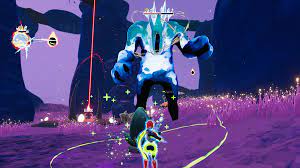
The rating shown on the left, and an in-game snippet shown on the right.
The video also describes ROR2’s in-game item stands/scrap stations which help the player change their build to their wish, but also explains the games luck based systems which determine how much loot a player has received by the end of the run, which can impact their progression drastically, for this they gave ROR2 a Luck 7 and a Skill 5.
Hades is up next, which is a isometric hack and slash Rogue-Like, which focuses on the player escaping hell, the videos delves into the games in-game difficulty settings, and it’s in-game progression on the weapons/skills and the currency which can be acquired in the game to upgrade them.
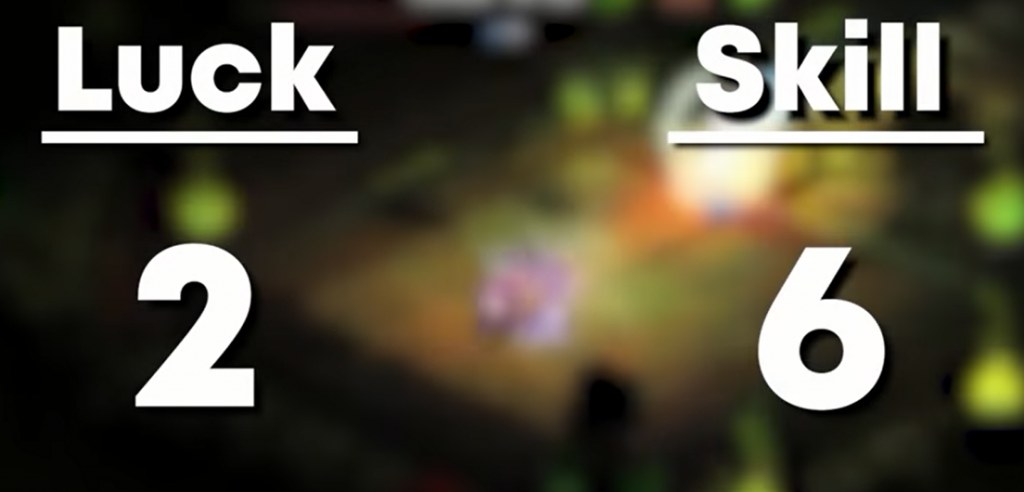
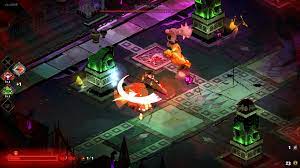
It also discusses Hades’s mid-run upgrades, and the room layouts being essentially set, also mentioning how the player can manipulate what items they get and can essentially change what skills and powers they acquire, furthermore also explaining the Bounties system/Heat Gage system, which is were the player can add additional challenges to their runs in order to unlock new items/make the game more challenging, for this Hades was given a Luck 2 and Skill 6.
Nuclear Throne is the next game to be discussed, which is a classic arcade-type Rogue-Like, the mechanics are simple and their isn’t much for the player to learn after the basic controls, this being said the game is rather hard, the player can die rather easily regardless of how they play, their being no objectively best build throughout the game.
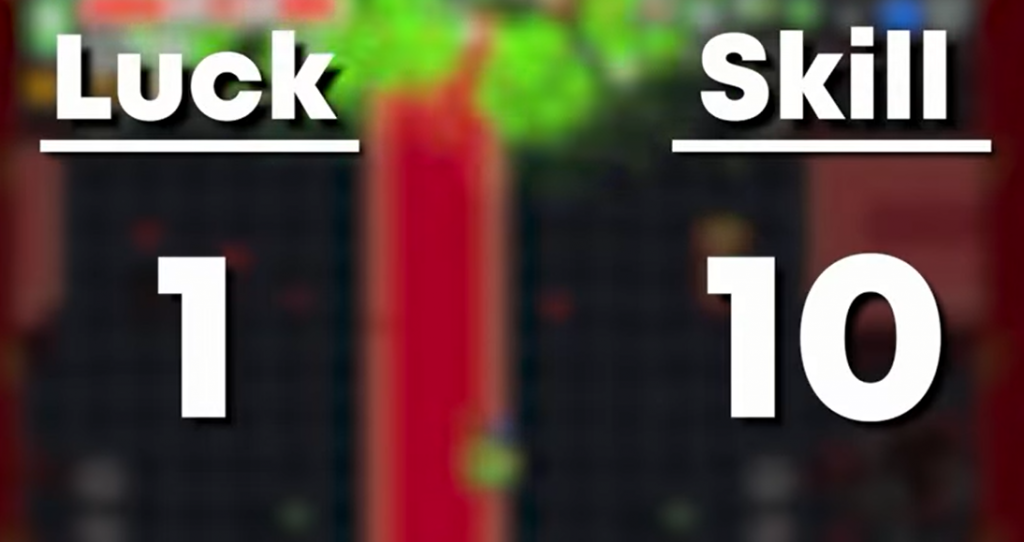
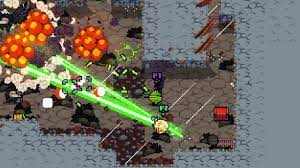
The games community notoriously cannot agree on anything, this is a good thing due to the game being viable regardless of what gear they are using, the game itself is built to be skill oriented, each and every strategy the player employs can be successful depending on how they play, and how they avoid death, for this the game receives a Luck 1 and Skill 10, the lowest and highest overall.
The second to last game reviewed was One Step From Eden (OSFE) which is a card based rogue-like whilst also allowing the player to move their characters, the player wins by using their cards in the bestpossible way, such as using fire against ice, the game also includes balancing issues, such as some builds being definitivley better.
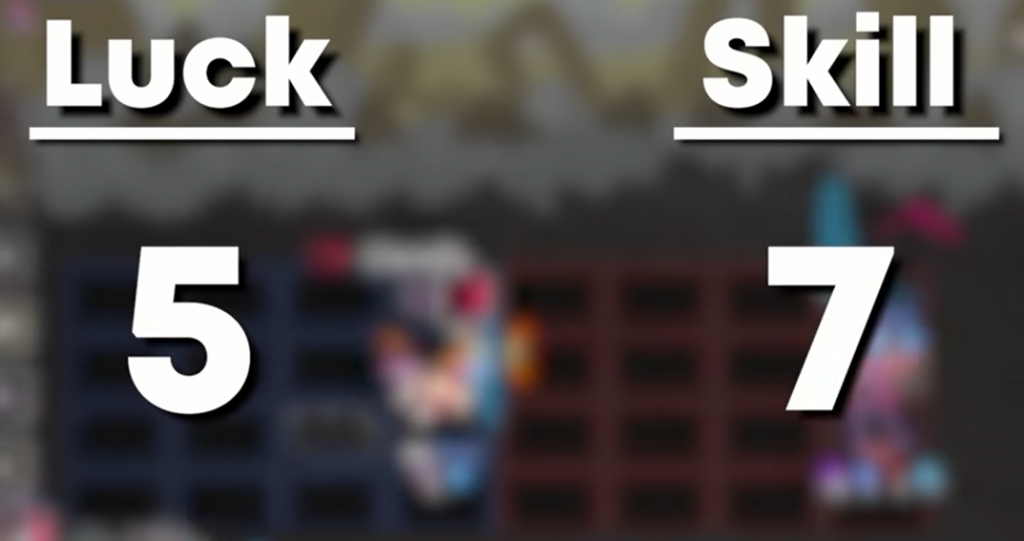
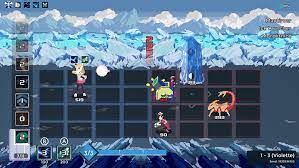
Whist the game can technically be beaten with the worst deck, it is extremely difficult, encouraging the player to play a certain way, this being said the amount of in-game spells essentially allow endless synergies between builds, allowing the player much freedom when selecting a deck, although some fights quickly devolve into button mashing and hoping for a good outcome, OSFE receives a Luck 5 and Skill 7.
The final game to be reviewed and discussed is Dead Cells, a game which is knownto be difficult, the game features no tier system, as all items have equal chance of appearing, the synergies the player can combine are vast, the game has a boss-cell system, giving the player a reason to improve.

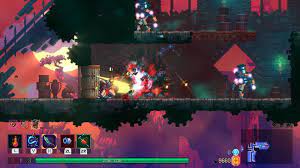
The game features difficulty increase after each boss is defeated, giving the players reasons to create the best builds they can, the game can be beaten without improving but it would be extremely difficult, although possible with enough skill, with all of this being said Dead Cells receives a Luck 3 and Skill 8.
Overall this video provided me with vast insight into what makes both a Luck-Based game and a Skill-Based game, and which games manage to tread the fine line between the two, it helped me decide which of the two I want to prioritise in my own game, of which would be Luck.
After looking into the deep mechanics of Rogue-Likes and what goes into developing them, comparing them and playing them, I decided to delve into the history of Rogue-Likes, to properly orient myself with some of the greats, which would potentially allow me to capture parts of these games and include them in my own.
The video initially develops into how Rogue-Likes where initially developed, explaining how the terminals that operated them where extremely segmented, having different codes all to do the exact same thing, the more terminals, the more codes that do the same thing, a library called Curses was developed to combine all of these codes, it was used as a graphical interface to develop the original Rogue-Like game “Rogue” in 1980.

Whilst being a commercial failure, Rogue inspired many similar games which introduced many of the original mechanics in Rogue-Likes which are still used today, such as permadeath and procedurally generated rooms and items, these games where dubbed “Rogue-Likes” as to pay homage to the original Rogue game that they where inspired by.
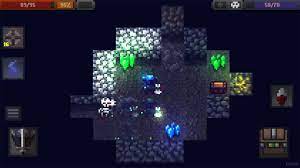

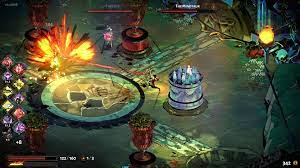

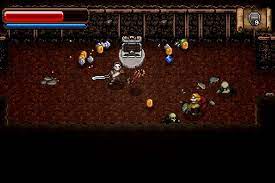
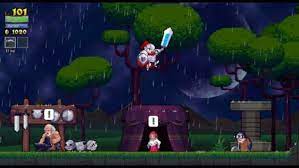
The second part of the video explained when the Rogue-Like term began getting traction in the early 1980’s, and received the archaic but accurate description of “single-user, fantasy role-playing computer games generally set in a dungeon run with a simple graphic interface” many of these games fell under this umbrella description but eventually branched out in the future, until Rogue-Likes have become an illusive genre today.

Rogue-Likes weren’t exclusive to the west, the east also released several new Rogue-Likes and flooded the market with hundreds of Rogue type games, but often landed flatly and where obscure, until Pokémon came onto the scene, which was technically by the definition at the time a Rogue-Like game, this boosted the genre massively and helped push it forwards onto thousands of new players.

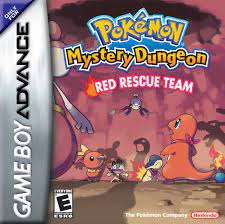
As time went on, many different developers gathered together and encouraged people to create their own Rogue-Likes, and formed in Berlin to create the aforementioned Berlin Interpretations, which set the groundwork for what modern day Rogue-Likes are based upon, although as mentioned before identifying a Rogue-Like is often difficult and isn’t as easily as other genre’s even to this day.

Immediately after the release of this interpretation a game called Spelunky was released, which challenged these pillars and took the defintion of a Rogue-Like differently, which raised the question of whether Rogue-Likes need to have all of the pillars or if they can branch of, and how to identify Rogue-Likes from a glance, as Spelunky was a side-scroller platformer, whilst also simultaneously being a Rogue-Like, it spawned a new wave of of-shoots which experimented with what made a Roguelike, these games being dubbed “RogueLites”

Rogue-Lites achieved immediate success, upon the release of Binding Of Isaac the genre was catapulted into the mainstream, gaining more eyes than it ever had before, the game changed how we define the genre and what fundamentally creates a Roguelite, introducing new ways of playing these games, such as Brawlers, Beatgames, Bullet hells ect.

With the addition of the confusing “RogueLikeLites” the genre becomes even more confusing to understand, but is evident that the Roguelike genre has had an effect on mainstream gaming as a whole, with the addition of mechanics such as procedural generation and random game mechanics and permadeath being some mechanics that Roguelikes tended to have, cropping up more and more in modern gaming, these are games that incorporate Roguelike mechanics into them.
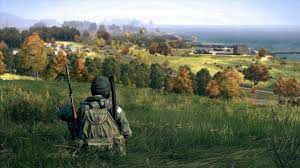
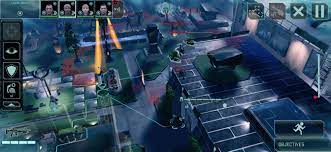
With the Berlin interpretation being continuously scrutinised and tested, the way we define Rogue-Likes eventually changed and has morphed throughout the years to include the 7 pillars I mentioned previously, proving that the genre has had many changes and differences throughout the years.
Eventually the natural evolution of the Rogue-Like formula for modern day gaming boils down to the following key elements:
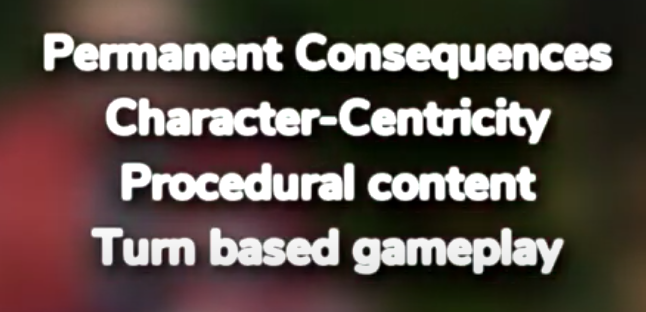
Overall this video was possibly the most helpful of the bunch, as it went into further depth on the key pillars of Rogue-Likes and how they have effected modern gaming, how they work and what these games came from/how they got to what they are, this is useful as I can infer what concepts and mechanics are most suited for my style of game.
Websites
After doing significant research about Roguelikes and how to make them on Youtube I decided to turn my search to secondary searches such as pre-done studies which have already been thoroughly investigates and dissected by somebody else, whether it be a company or an individual, these studies and essays may be helpful in my pursuit on understanding how to create a functional roguelike.
University XP ‘Roguelike Learning’
https://www.universityxp.com/blog/2019/8/27/roguelike-learning

The first piece of info I managed to discover was a study conducted by University XP, which is a website which studies a whole host of different topics and concepts, one of these being gaming, the title of the study being “Roguelike learning” it was immediately obvious that it was talking about the topic I wished to learn more about.
The article initially delves into what Roguelikes are, and much like previous interpretation of them, it also ran into problems when properly describing Roguelikes, but managed to narrow down their own interpretation into Dungeon Crawling-Permadeath-Turn based games, which is a fair analysis of the genre.
It then goes onto describe where the term Roguelike comes from, talking about the original Rogue game and the offshoots which came from it, it also describes that the initial game was difficult, which is what spawned the notorious difficulty that often comes with these games.
It then goes into the depths of what makes up a roguelike, listing some of the previously known pillars for the genre;
-Random generation that aids the game’s reliability
-Permanent death of the character which prevents players from picking up where they left off
-Turn based actions
-Resource management
-Map exploration
-Complexity generated from simple systems
-Controlling a single character
These pillars have been seen in the interpretations listed above, with the addition of some new ones and reduction of others, the list is near enough identical, although worded differently, this yet again shows that the general consensus of what a roguelike is has been established, but offshoots and differences still commonly exist.
The study then continues on to investigate as to why these game are so interesting, delving into one of the main attributes of roguelike, that being learning from experience, it details how player are usually unable to respawn with what they had or with more in Roguelikes, which is unlike games of other genre, which often allow the player to respawn unimpeded, this is further explained in how the article describes “runs” which are what the players conduct each time they play the game, the player starts, thus beginning the run, fights through the dungeon or area and wins, or dies, ending the run, these factors play a key role in how these games are so fun, as no experience will ever be the same.
It describes how the player will have to learn from their mistakes in Roguelikes, having to adapt and change as they play, perhaps taking on a new playstyle, carefully planning their next actions according to the enemies, instead of blindly rushing forwards, deepening on the game and its difficulty the player may even need to find a meta build to compete with higher teir enemies, all of this accumulates in growth for the player, as the player grows more experience and hardened they get better at the game, and can win more often, or get better rewards/more clean runs.
The article then goes onto describe the relationship between roguelike and learning further, explaining how through repetition the player can learn and needs to learn new things to continue and do better, the game force the player to use their brain if they wish to excel, comparing the often used Permadeath mechanic to school learning, using everything they have learned and combining it into a final paper, or a new run.
The study then closes of by talking about the difficulty of Roguelikes, and how it helps develop learning experiences and challenges for the player, explaining the metaphorical scaffolding that holds these games together, explaining the similarities between Roguelikes and learning/teaching once more and covering the topic broadly lastly, detailing the importance of feedback in Roguelikes, which is the growth of the player throughout their gameplay.
This article was overall rather helpful as it broadly explained the aspects of what a roguelike is, refreshing my memory after a break of which I spent learning coding from home, it helped me further understand the basics of what these game are, and gave me another way of looking at it.
Hades: a case study in storytelling for roguelike games
https://www.davideaversa.it/blog/hades-case-study-storytelling-roguelike-games/
The article starts off my speaking on the popularity of the game Hades, of which I will do a breif summary of below;
Hades is a roguelike dungeon crawler developed and published by Supergiant Games and was initially released in 2018, but gained mass popuarlity and critical aclaim in 2022.



The article goes onto to describe as to why Hades has achieved its monumental success within the roguelike gaming world, talking about its unique and groundbreaking storytelling, which links into how the game is played and progressively gets more coherent and understandable, until the player is invested in the story and wants to move forwards to pursue it.
Many Roguelikes before Hades have attempted storytelling and attempted to intertwine it with the players gameplay, but often due to the nature of Roguelikes storytelling becomes rather difficult, as getting emotionally attached or knowledgeable of certain characters or settings is difficult when the world is ever changing, Hades does this in a way of which seamlessly integrates itself with the game, plotting the main character against his father Hades, attempting to escape the underworld (levels) which are ever changing to attempt to stop him.
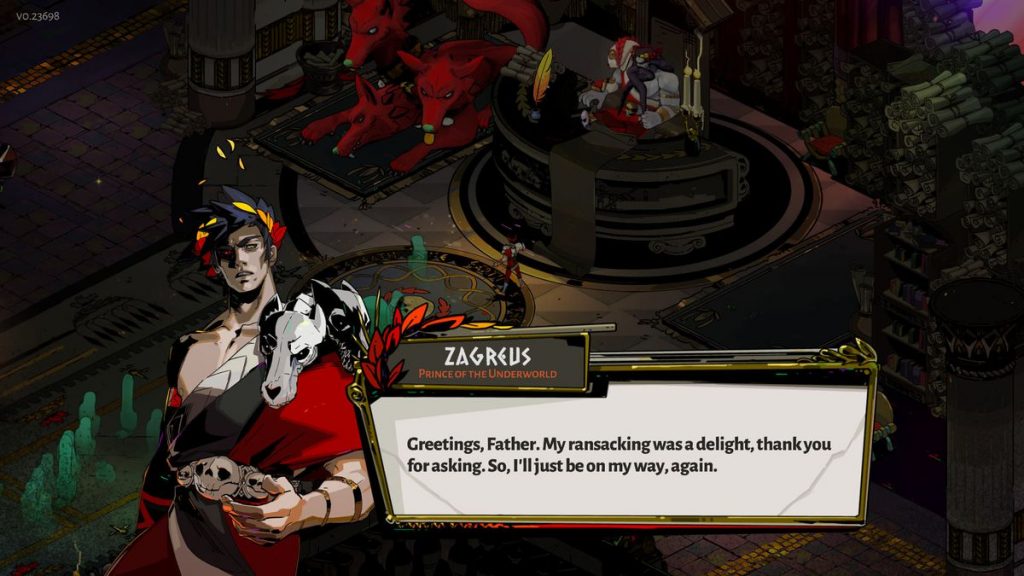
The article later goes onto elaborate as to why Roguelikes didn’t tend to care about story as the difficulty of telling a coherent story was too much, as the players “runs” where usually self contained stories that changed with each run, Hades was one of the first games to change this and to create an overarching story which changes the current player characters outlook and abilities depending on it, focusing on the key reason many have failed before, reason, this being the reason the player character seemingly comes back continuously and retries the same thing over and over, this is explained wonderfully in Hades, as the player characters is a god who is literally stuck in the underworld, the domain of the dead.
It talks about the other characters in the plot, these being the Grek gods and w hole host of underworld caretakers and workers, including Hades himself, which the character is able to talk too and build relationships and friendships with, this is one the main building blocks as the game, as the player character can progress his relationship with these characters by gathering certain items, which can be found during their runs, this further incentivizes players to continue and pursue more runs.
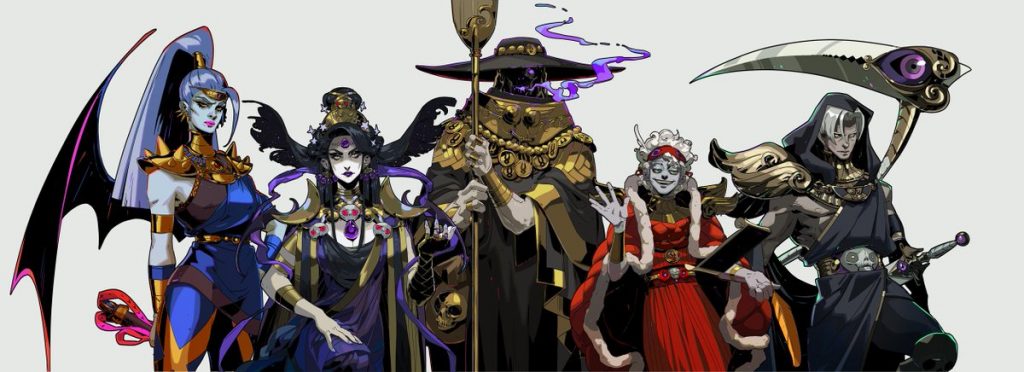
The game features various different Olympian gods for the player to interact with, they can give the player favors and abilities which will help him in his run, this helps build story as these gods will have different voice lines and interactions at different times, always keeping things new and exciting, this is especially useful in a narrative sense as the player doesn’t know what to expect.
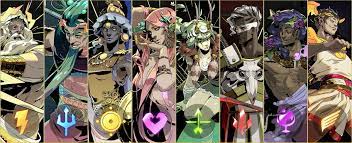
Overall this article was somewhat useful as it highlights the narrative structure of one of the most popular roguelike games, it shows that these games can have a story if done right, this is good to know as if me and Salman wish to change anything and add an overarching story to our game we can, meaning that overall we have a larger variety of options.
Roguelike – Wikipedia
https://en.wikipedia.org/wiki/Roguelike
The next website I decided to visit to gather information and knowledge from was Wikipedia, whilst the site has a bad reputation due to the common belief that anyone can change it contents, it is till extremely useful on gathering knowledge on a whole host of topic, whilst still being mostly reliable, this site has helped me numerous times in the past and has always provided reliable information.
When visiting the page on Roguelikes, it immediately starts of by defining what a roguelike is, talking about what the term means and how it came to be, it talks about how the majority of Roguelikes are tabletop/d&d esc games, which is fairly correct, it then goes onto describe Rogue, the first proper Roguelike game, as I have discussed many times before Rogue is the precursor to all of these games and effectively coined the term Roguelike.
It then goes onto describe how the term Roguelike is up to debate, mentioning the berlin interpretation a seen before, it talks about the factors that create Roguelikes and what the interpretation is, it talks about some of the games which didn’t strictly follow this newly made interpretation of High Value Factors, these being Spelunky, Binding Of Isaac, Faster Than Light and more, it also explains how these games are still considered Roguelikes, even though they clash with these previously mentioned pillars of what makes a roguelike.

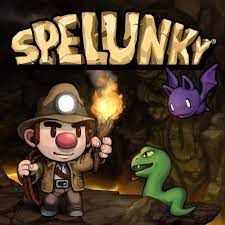
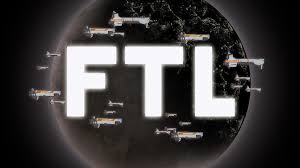
The article then delves into the origins of the term, talking about how it originally came from a USENET newsgroup in 1993, which was a channel that players of these games would come to discuss thing related to them and gaming in general, it was also used by developers to announce new games and titles, it discusses how with the rising popularity of roguelike games the gamers struggled to categorize them, so they decided to invent a term that would be used to order these game in the future, that term being Roguelike, effectively creating the new genre with it, it goes onto discuss the debate surrounding these games and how the genre is still under construction, it then elaborates on how the term was similar to another at the time, which encapsulated modern day First Person Shooters, that term being “Doom Clone” explaining how the community tended to categorize to make labelling these games easier.
The page then goes onto talk about the general gameplay mechanics of Roguelikes, talking about how these types of games tend to be centralized around Dungeons & Dragon esc mechanics, how they also tend to give the player control of a character, allowing them to customize them in a variety of ways, these being looks, race, attributes, skills, points and gender, class ect, they usually give the player a large amount of control of their playthroughs, it also describes how these games usually give the player some starter equipment, and a tutorial of sorts to get them used to the controls, it delves into how dungeon crawling Roguelikes tend to have treasures the player can grab and treasure chests they can open, which may contain useful items such as food, potions, weapons, armor, it also explains how combat in tabletop Roguelikes work, the player usually only has to walk up to an enemy to engage in combat with them, being able to choose their attack and or action.

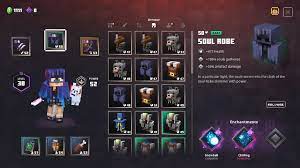
Then continuing on it talks about how these games tend to have an experience system, a system which allows the player to progress, usually they gain experience by killing enemies, completing quests, clearing dungeons ect, this experience eventually accumulates into levels which they can use to spend on attributes and skills, increasing their power in a certain field, this allows for lots of variety as the player can specialize in anything they want, or can generalize in everything, choosing to become a mage, warrior, archer, rogue, barbarian, spellsword, ect.
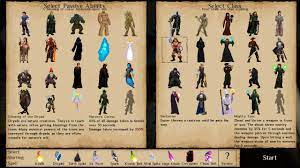
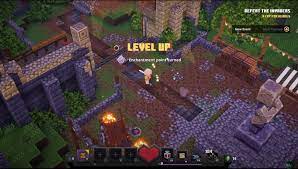
It also explores the concept of Permadeath, which is the permanent death of the player character, meaning they will have to restart completely when they die, this is what separates the Roguelikes from the Roguelites, usually having to restart and create a new character when dying in a roguelike, but being able to restart their run in a Roguelite.

Then the page talks about how the games tend to have a “Fog Of War” which essentially means that all unexplored rooms are obscures to the player, meaning they cant see what’s inside them until they enter, they may be able to see previously entered rooms contents however, some Roguelikes may require a torch to allow the player to properly see their environment, this adds more strategy to these games as the player will have to prepare and evaluate the situation.
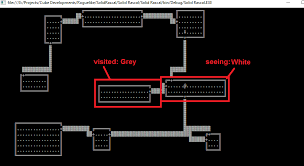
It explores how these dungeons tend to be connected by something, usually stairs or a portal/door, which can lead down to another level or a boss area/secret area, generally these lower levels tend to be more difficult, meaning that an underdeveloped/underleveled player will struggle to pass them, since the dungeons are usually RNG based (procedurally generated) the players will have to be constantly on guard and ready to adapt to the situation.
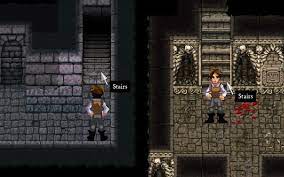
It continues into the fact that certain games will give the player an indication as to if the enemy they are facing is a boss or a miniboss, usually a healthbar or a skull, this is helpful as it indicates to the player that what they are fighting is important, and stronger.

Moving onto the discussion of the games goal, most Roguelikes tend to have a final objective such as an item the player wishes to collect, a character they wish to save, or a quest they wish to complete, this is done to give the player a reason to continue.
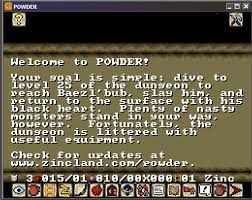
It then goes onto explain how the game generally accumulates the players progress in a run into a single score, which may go onto a leaderboard which can be seen by all, this incentivizes players to reach new heights in hopes of being on said leaderboard, creating even more runs.
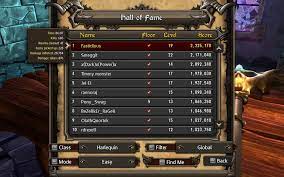
The article then goes onto explain the interpretations (key pillars/high value factors) that I have previously discussed above, it talks about how they are heavily debated and how new factors are being used as time goes on, then continuing onto explore the history of Roguelikes, and what a Roguelite is, these are non useful as I have already explored them previously or I’m not intending on using the info that would be gathered from them.
Overall this article was extremely insightful, as it showed a very detailed overview on the mechanics that go into these games, things such as health systems, armor, weapons, procedurally generated rooms, enemies, treasure, class systems, player progression, player choice, skills/attributes and so much more, it has influenced me heavily on what I wish to add to my game.
Reviews
Continuing on with my secondary research gathering, I decided to tap into a different source of information, that being reviews on already existing Roguelikes, I believe this avenue may be insightful as it would show me other peoples perspectives, and people that are more adept at Roguelike design/what they think of these games, potentially exposing any potential problems that may arise in development.
The first review I decided to look at was of a game I have already previously covered in my primary research gathering, this being (Moonlighter) I decided to pursue this game as it was closely related to the game I intend to make, and is a game I regularly play and enjoy, I also chose it as I wish to learn more about the game to gain a better understanding on as to what makes it so enjoyable to play.
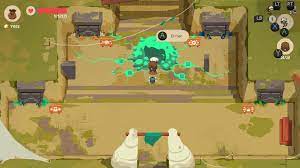
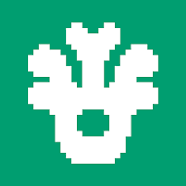
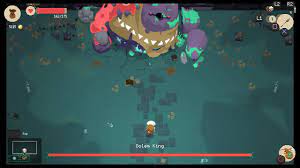
For this section I decided to split it up into 3 parts, meaning that I will gather information from 3 separate reviews, I have done this because reviews tend to be opinionated (qualitative research) therefor they aren’t always the most reliable sources of information on the games actual gameplay, that being said these reviews will show us insight into what the general population and fanbases think of these games (Roguelikes) and Moonlighter.
Upon searching for reviews on Google, i was shown some quantities info on reviews of the game, these being from large websites like Meteoritic and Nintendo Life, this highlights the scoring system that these reviews tend to use, usually reviewing between the numbers 1-5 or 1-10, the latter being the highest and the former being the lowest score, they may also use a % rating between 1-100.

To start myself of and get into the Moonlighter reviews i decided to click on one of the suggested reviews for the game on the Youtube recommendations underneath the previously discussed reviews, its a 2 minute review by the Youtuber Gameumentary, it will give a brief overview of the game and some of its mechanics, compiling it all into a compact 2 minute clip for anyone interested in the game.

The review starts of by explaining what Moonlighter is, he explains that Moonlighter is an action-RPG with Roguelike elements, where the player starts of as a character called Will, who is trying to restore his shop back to its former glory by exploring the 4 dungeons, in a quest to unlock the mysterious 5th dungeon door, whilst being a shopkeeper who sells his loot from the dungeon runs.
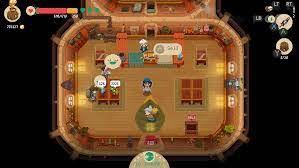
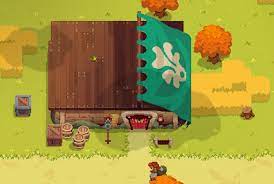
He then goes onto describe how at night Will ventures into these dungeons to gather loot to sell in his shop, explaining how the deeper he delves the more valuable treasures he can acquire, but in doling so he may also face tougher opposition in enemies, such as bosses and mini-bosses that he may have to overcome to progress.
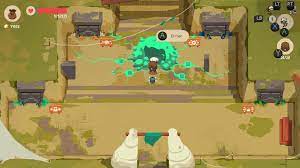
The video then goes onto explain the progression in-game, talking about how if Will completes more dungeons, he gathers more loot which he can sell to upgrade his shop, which in turn will allow him to acquire better gear as he has more money to spend, and so on and so forth until he has gotten the best gear in the game and beat all the dungeons, it isn’t an original progression path but it is implemented well and with solid groundwork.
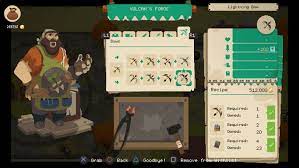
It then continues on to explain how the variety within the game keeps things fresh, with the player constantly entering new and unique rooms with differing patterns and layouts, meaning that they never experience the same variation of enemies and loot in any given run, this keeps the games gameplay fresh and replayable, something that I most certainly want in my own game.


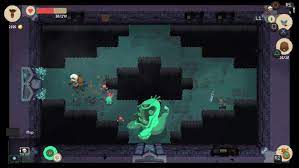
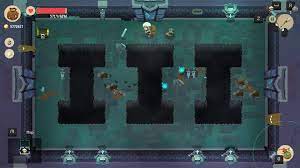
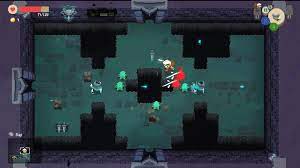
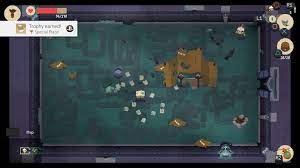
It then moves on to discuss the shopkeeping element of the game, talking about how its a refreshing break from dungeon-crawling and fighting monsters, it allows players to focus on something else for a while, and let them see their loot gathering actually pay off, as they top up their money by selling any items they wish to sell, at a value they believe is acceptable, also talking about how the price altering lets the player work through what prices and accepted by the NPC’s and which aren’t letting them learn over time which items are worth what.

The video then closes of by running over the key points that where discussed during the video, discussing the story, dungeon crawling, merchants, shopkeeping dynamic and overall gameplay, suggesting the game to potential players, although not giving an overall score.
This video was insightful and would be useful for anyone who wants a brief rundown on what the game is, what its about, and how to play it/what it contains, it helped me refresh my memory on the in-game content and how to play the game, overall being pretty useful.
The next review I decided to look at would be from the largest video game rating company out there, that being IGN, I chose this as it would give me an industry look into what such as large company would think, as IGN is so large they tend to use more quantative info, which can be helpful in my search for what makes Roguelikes like Moonlighter enjoyable.
https://www.ign.com/games/moonlighter

Since IGN reviews thousands of games they tend to use shorter quantative info type reviews, this isn’t true for massive games that are new, they tend to post on their Youtube channel for those ones, I am focusing on their websites articles strictly as they offer much quantative info.
Starting off IGN shows the reader the games name, its artwork/thumbnail, what platforms it’s available on and when it was released, they do this to give the reader a proper grasp on what they are looking at, and to perhaps help them navigate through which platforms they can play the game.
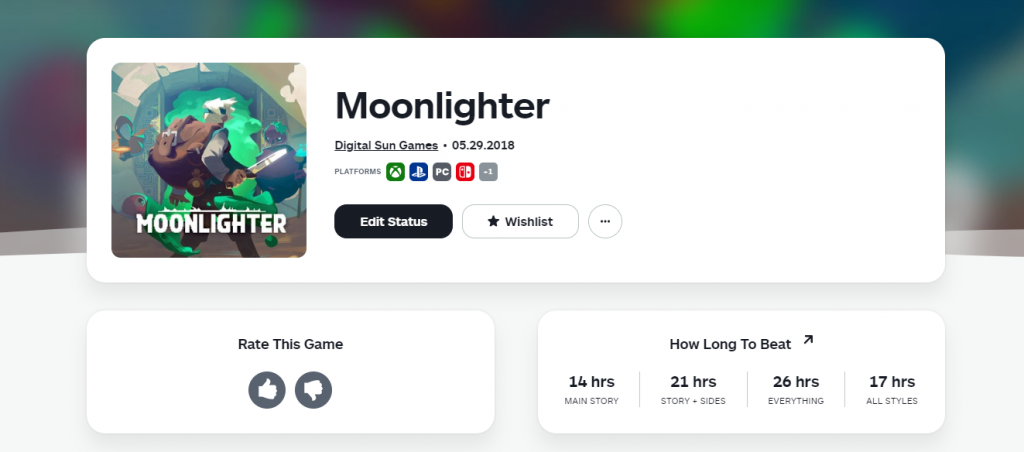
Moving on they provide in-game screenshots and a trailer/video for the game, this gives viewers a good look into what the game is, what it’s about and how it looks, this is helpful as it gives viewers something to look at, allowing them to familiarize themselves with the games mechanics/features.

Onwards, IGN produces a short Summary of the game, its creators, publishers, release date, and several other helpful quantitative facts, which are all useful in establishing who made the game and when.

Finishing off, IGN lists any news related to the discussed game, this is extremely useful as it allows me and other viewers to look at what is currently going on in the game, these news articles may discuss potential updates or fixes/bug patches, new content ect.
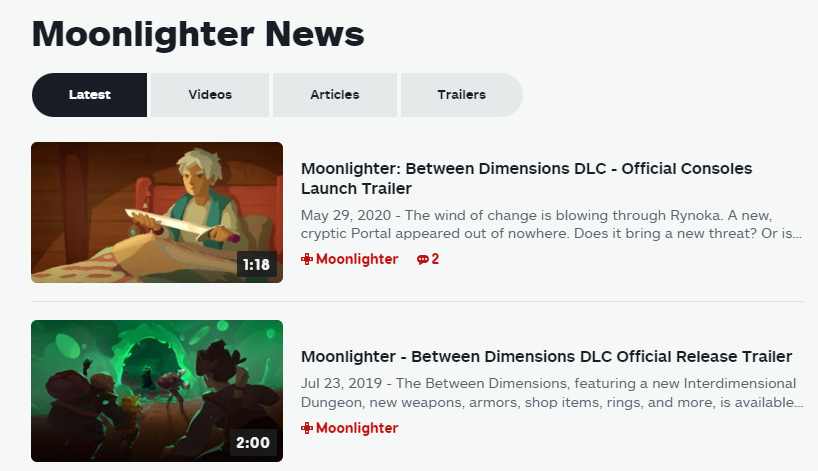
Overall I found this review somewhat useful, as it gave me alot of quantative info of which I was lacking beforehand, as reviews tend to be qualative in nature, it is helpful to get a large companies review to avoid bias, I learned some new things about Roguelikes, such as how they can be on multiple platforms, which may potentially be useful in my own game.
The final website I decided to look at for a review is Metacritic, it’s a large reviewing platform which has both game critics and user critics, meaning that I can gather both qualative information and quantative information simultaneously, this is helpful as I am able to look at everyone opinions and thoughts on the game.
https://www.metacritic.com/game/switch/moonlighter
Much like IGN, Metacritic starts of by giving a brief overview of the game, where it came from, who made it, when it was published and released ect, It also gives a photo and a general score, the score being 83, which is labelled as a “Metascore.”

Moving on Metacritic shows the viewer the trailer to said game, which is helpful as it allows them to get a brief glimpse into what the game looks like and what its about, helping them decide if they like it.
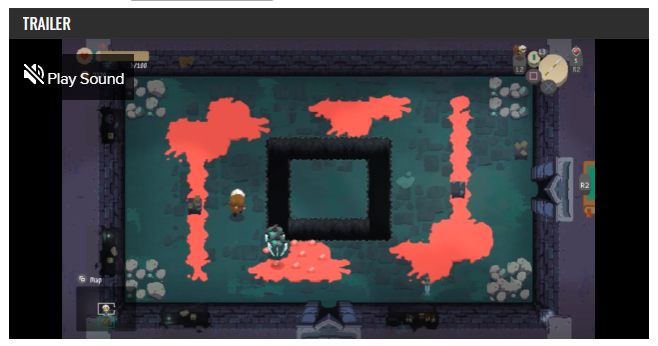
After this Metacritic shows the viewer all of the reviews from both game critics and normal users, this shows more qualative info, giving us a whole host of opinions and different thoughts on the game, It helps me understand what people like and don’t like about the game, which in turn helps me understand what people generally dont enjoy about Roguelikes, and what they do enjoy.

Overall this review was helpful as it was more of a listing of several hundred different reviews, many of which I personally looked through and managed to gather some notes from, which will help me in development as deciding what I want is now easier.
One other piece of research I thought about conducting was some research on the software of Unreal Engine 4 itself, whilst I thought this may be helpful I haven’t done as much as I have into rogue-likes due to me already having a decent amount of prior experience in using the software, their were still a few things i was interested in finding out, these included the following.
How to make a functional AI.
I chose this as i was familiar with the majority of skills and techniques used to create the game I intended to make, the one technique that I didn’t know how to do was the construction of an AI which functions and chases the player, I needed to know this as the primary enemy is an AI which follows the player and does damage upon contact.
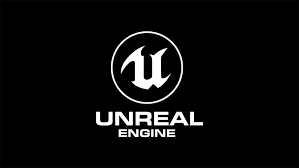
I decided to investigate this to find out how to make a functional AI, I first looked online and on various sites, until I came upon the site Verluis, this website helped me find out all sorts about Unreal engine, it had many different tutorials on a wide range of topics, including software like Blender and Photoshop, the first I looked at was the topic “Setting up a simple AI controller in Unreal Engine” by Jaw Versluis.
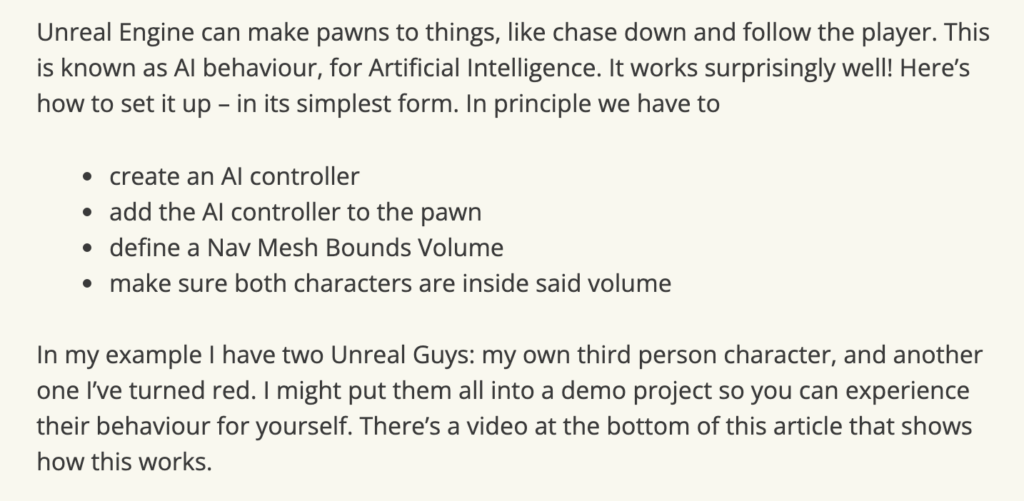
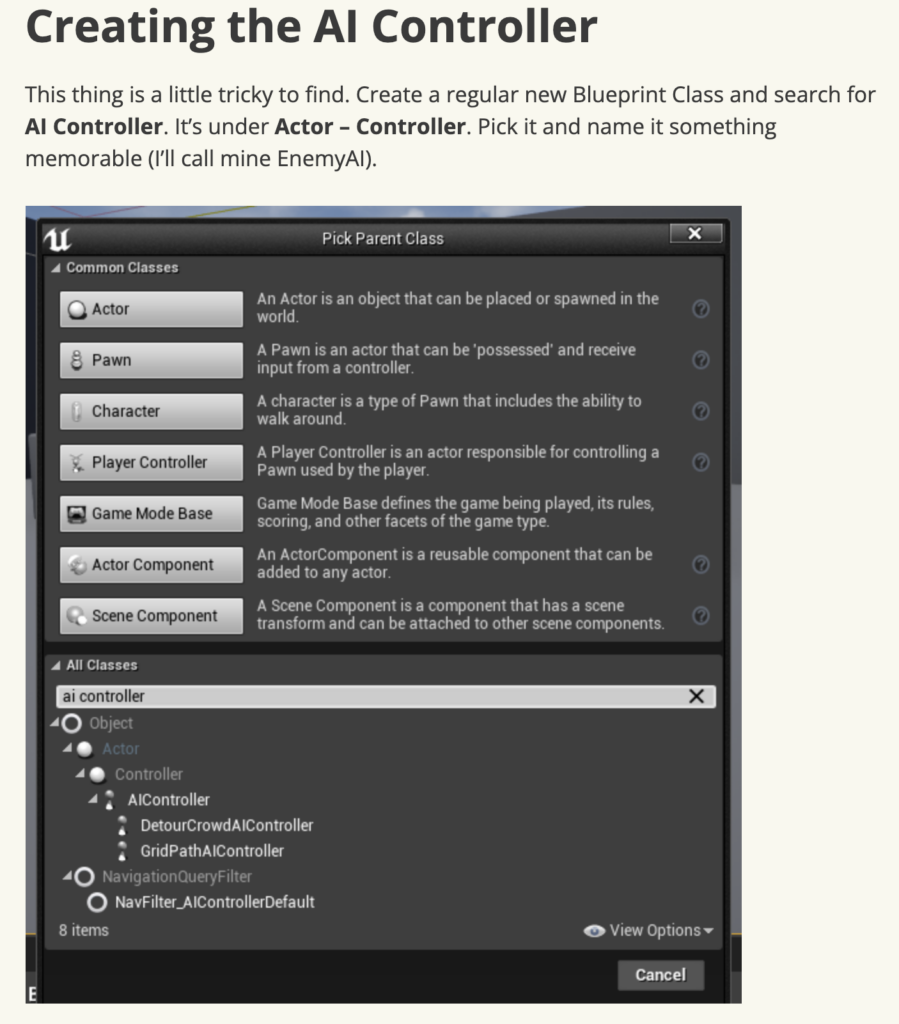
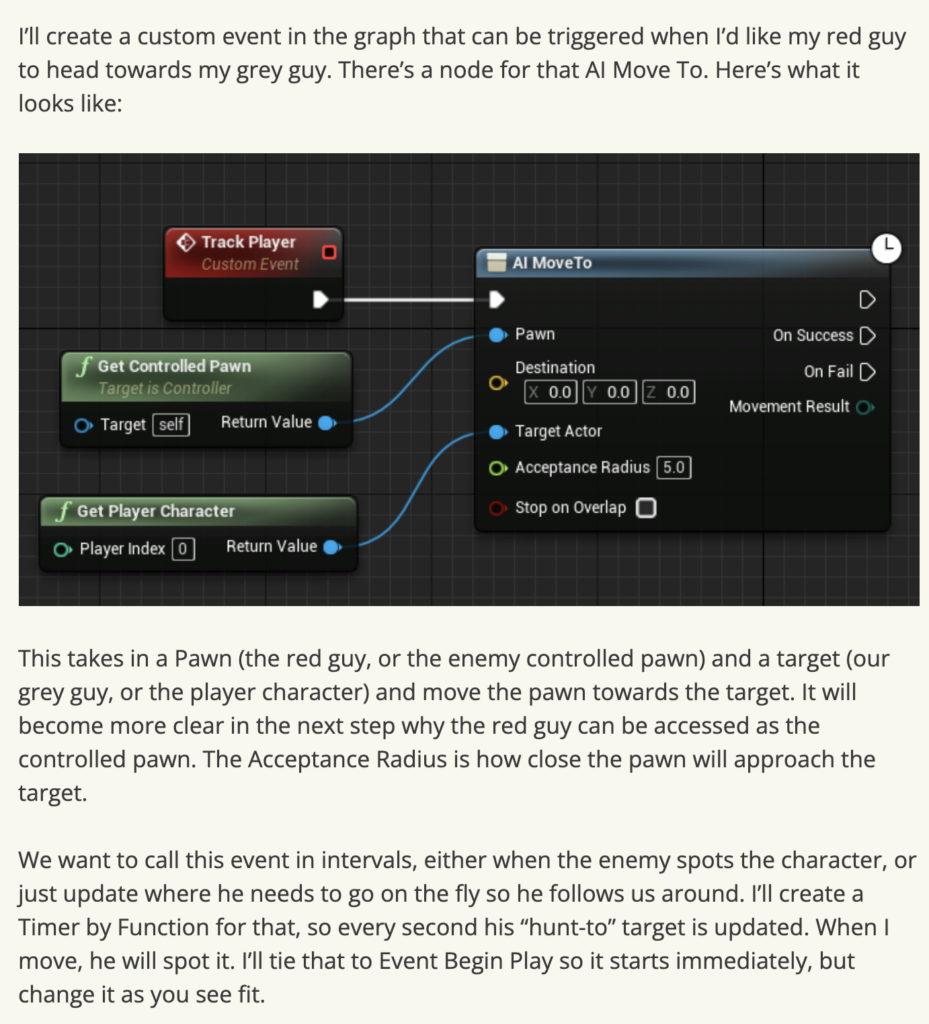


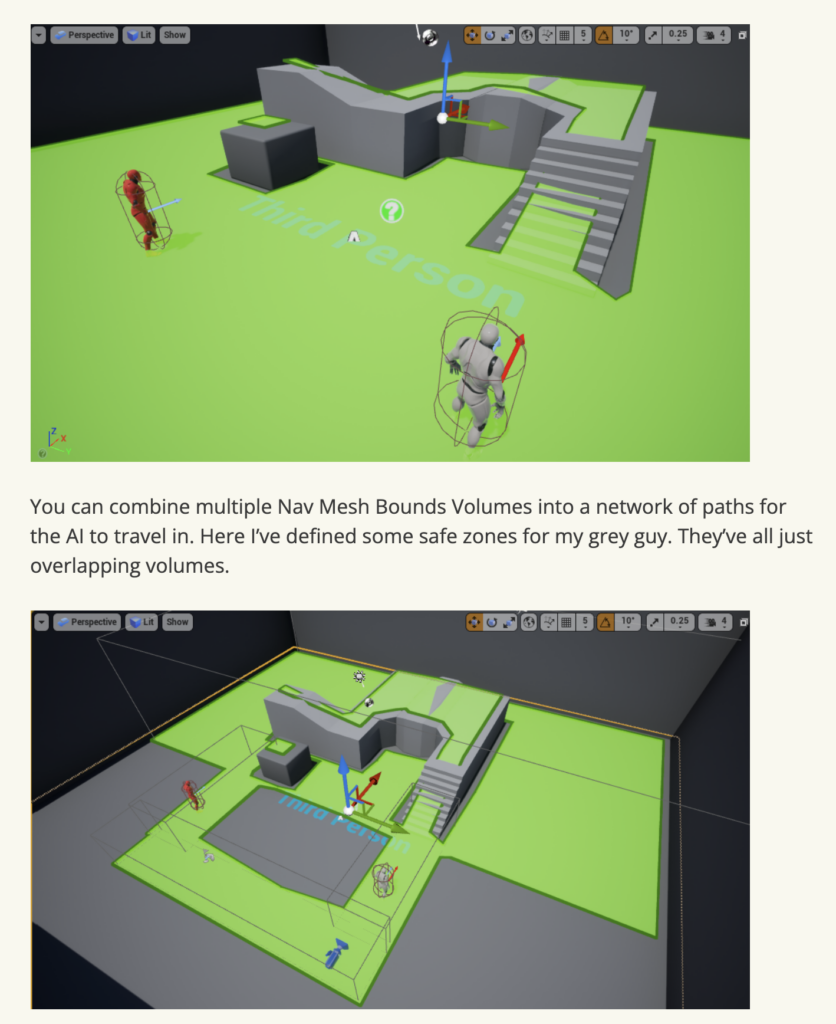
Overall this tutorial was very insightful and helped me understand how to construct an AI within Unreal Engine 4, this was inevitably very useful when I created the AI in the game, using the same basic concept with some adjustments to account for the AI’s downsized 2D nature.
With everything said and done I believe I have finished my secondary research, and hope whomever is examining this finds it acceptable, I gathered many different useful pieces of information and ideas/concepts which will help me in development, I cannot overstate how much investigating these games has given me inspiration.
